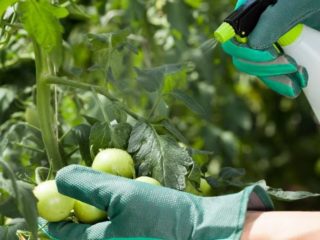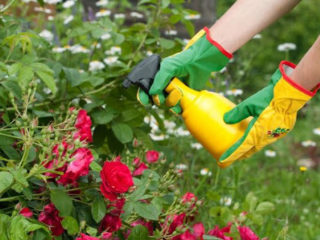Content
Treating raspberries with ammonia strengthens the plant’s immunity and serves as a preventive measure against illnesses. In this case, it is necessary to remember the toxicity of ammonia and follow the rules for using the product.
Why spray raspberries with ammonia
Ammonia, or ammonia solution, contains easily digestible nitrogen. This substance is necessary for plants for the rapid development of green mass and is of particular importance in the spring. In addition, ammonia vapors are poisonous to harmful insects. The product can be used to prepare an affordable and effective insecticide.
It is allowed to use a 10% ammonia solution from a pharmacy for root feeding of raspberries and spraying. When used correctly, the drug:
- accelerates the development of shrubs;
- promotes rapid growth of shoots and young green leaves;
- improves photosynthesis processes;
- strengthens raspberry immunity;
- repels insect pests and serves as an insecticidal agent.
The use of ammonia for raspberries allows you to avoid stronger and more expensive fertilizers, for example, saltpeter or mullein.

An aqueous solution of pharmaceutical ammonia is alkaline and helps prevent acidification of the soil in the area
Advantages and disadvantages
Ammonia for processing raspberries has both advantages and disadvantages. The advantages of the solution include:
- good digestibility of nitrogen present in the composition - fertilizing almost immediately has a positive effect on raspberries;
- accessibility - you can purchase the product in the required quantity for little money at any pharmacy;
- harmlessness - if the rules for preparing the working preparation are followed, ammonia does not cause any damage to plants;
- anti-parasitic effect - when using ammonia, fertilizing can be combined with insect repellent treatment.
However, ammonia has some disadvantages. Among them are:
- volatility of the solution - ammonia evaporates quickly, and it must be used immediately after preparing the drug;
- average effectiveness - as an insecticide, ammonia is effective only in cases of weak pest infestation;
- toxicity to beneficial insects - if spring spraying is carried out too late, raspberry fruiting may deteriorate due to insufficient pollination;
- danger to humans - if you prepare the solution in violation of the rules, it will cause burns to the mucous membranes of the eyes and respiratory system.
It is best to use ammonia for spring feeding of raspberry bushes and for preventive treatment against insects.

If pests attack the plant in large colonies, it is better to use industrial insecticides
When to treat raspberries with ammonia in spring
Spraying raspberries with ammonia can be done at the earliest possible time in the spring. It is only necessary to wait until the air warms up to a temperature of 10 ° C, otherwise the bush will not be able to absorb nitrogen well.
You need to fertilize before the raspberries begin to bloom. It is usually recommended to water and spray in April, immediately after warm weather sets in. In this case, ammonia will not only have a stimulating effect on raspberries, but will also help destroy most of the pest larvae that wake up after wintering in the soil and under the bark.
Processing methods
There are several ways to treat raspberries with ammonia. In any form, the solution benefits the shrub, but to achieve maximum effect it is recommended to combine several methods. Typically ammonia is used:
- For spraying. It is recommended to dilute ammonia in water with the addition of tar or laundry soap. The last component will not only serve as an additional antiseptic, but will also add stickiness to the finished mixture. The ammonia solution will be able to remain on the leaves and shoots longer, and the nitrogen will evaporate more slowly.
- For watering. Ammonia is diluted according to the instructions and applied under the raspberry bush using a watering can with a large sieve. Immediately after this, the plant is watered abundantly with clean water to prevent possible root burn.
- For sprinkling. A solution of ammonia can be added to the device for irrigating raspberry bushes. In this case, the useful product will fall both on the leaves of the plant and on the soil around it.
How to dilute ammonia for raspberries
The rules and proportions for diluting ammonia depend on the purpose for which the solution is to be used. Typically, a more concentrated product is prepared for insecticidal treatment, and a liquid containing small volumes of ammonia is used for fertilizer.
Ammonia for raspberries against pests
Ammonia vapors released by ammonia lead to paralysis of the respiratory organs of insects and to their death. You can prepare a good insecticidal agent at home that helps with the invasion of aphids and weevils using the following algorithm:
- About 25 ml of ammonia are dissolved in 10 liters of lukewarm water.
- Mix the product thoroughly.
- Pour the solution into a garden watering can with a large sieve.
- Water the bush at the root and along the lower leaves.
One bucket of product should be enough to treat 4-5 plants. There is no need to infuse the ammonia solution after preparation; on the contrary, it is better to use it as soon as possible.

To spray raspberries, you need to prepare a solution in the proportion of 50 ml of ammonia per 10 liters of water
Fertilizing raspberries with ammonia in spring
A video about feeding raspberries with ammonia suggests carrying out the procedure twice in the spring. The solution is used for the first time in April after stable heat has been established. A useful remedy for raspberry bushes is prepared as follows:
- Two large spoons of pharmaceutical preparation are dissolved in a bucket of water.
- Mix the product properly.
- If desired, add 100 g of liquid or crushed laundry soap to the solution.
- Stir the product again.
Immediately after this, foliar feeding of raspberries with ammonia is carried out and the solution is added to the soil - 5 liters for each bush.Ammonia stimulates the development of shoots and destroys parasites that have waited out the winter in the soil under the plant.
The second spring treatment of raspberry bushes is carried out shortly before flowering in late May or June. The drug stimulates the formation of buds and promotes the formation of a large number of ovaries. The working solution is prepared as follows:
- Dilute about 45 ml of pharmaceutical product in 10 liters of settled water.
- Mix properly.
- Spray the bush leaf by leaf, trying to treat the raspberries as evenly as possible.
When caring for a plant, ammonia can be combined with other beneficial agents. For example, it is allowed to add a little iodine to the working solution. The substance also has insecticidal and strengthening properties and increases the endurance of the shrub. The proportions when feeding raspberries with ammonia and iodine are kept small - no more than 5 ml of antiseptic is added per 10 liters of solution.
Before flowering, watering or spraying with ammonia is carried out no later than ten days before the buds open. Ammonia must have time to dissipate, otherwise its vapors will scare away not only pests from the bush, but also beneficial insects involved in pollination processes.
Ammonia for raspberries in summer is usually used closer to autumn, after harvesting. The third feeding helps restore the bush's strength after fruiting and prevents infection by pests, many of which become active again in August. But at a later date, it is no longer possible to use ammonia, since in this case nitrogen will negatively affect the frost resistance of the plant.
Rules for using ammonia for raspberries
When feeding raspberries with ammonia, you need to follow certain rules that guarantee the safety of the bush and the gardener:
- When preparing the working solution, follow the instructions exactly and adhere to the proportions of adding ammonia. A too concentrated preparation will harm the plant and impair its health and fruiting.
- Before carrying out root feeding, the soil is moistened abundantly. At the end of the procedure, the bush is watered again with clean water. You cannot use only ammonia solution to add to the soil - it will burn the dry roots and damage the plant.
- Working with ammonia must be carried out with precautions. You need to use rubber gloves, a respirator and safety glasses. Toxic ammonia vapors can cause damage not only to insects, but also to humans, in particular, cause burns to the mucous membranes of the respiratory organs.
- When spraying and watering raspberries in a greenhouse, it is necessary to open windows and doors while working. The drug itself should be prepared outdoors.
If ammonia gets on your skin, you should immediately treat the affected area with plenty of soap and water. If the mucous membranes of the eyes, nose and mouth are affected, it is also necessary to urgently rinse and consult a doctor to prevent dangerous consequences.

It is recommended to spray raspberries with ammonia in dry weather early in the morning.
Conclusion
Treating raspberries with ammonia helps feed the bush with nitrogen and protect it from pests. If the basic rules and proportions are observed, ammonia remains completely safe for the plant and does not cause damage to its health.








